- Bernard Preston homepage
- Beekeeping
- Swarming Bees
Swarming bees
A cloud of swarming bees is the easiest way to increase the size of your apiary. For the smaller-home three colonies is a good number; those having a larger piece of ground, with borders of thick bushes protecting the neighbours might enjoy more.
Simply place a box containing the scent of bees on your roof in the swarming season; you will first find scouts checking out your inviting trap-nest and then with luck the whole colony will arrive within a few days.
Reviewed by Derek A. Lewis, beekeeper.
Introduction
Reproduction in the honeybee lifecycle occurs in two ways. During a honey flow there's natural growth within the hive as the queen starts laying more eggs. An increased number of workers are needed to collect their food; nectar and pollen which are their carbohydrate, protein and some fat.
Bees in nature only eat pollen and raw honey for carbohydrate; it is quite different to the supermarket stuff.
Take a blinded test if you do not believe me, comparing the fragrance and taste of raw versus processed honey; take the lid off the bottle and first have a sniff.
And the sweetening of our food, in moderation like all simple and refined carbohydrate, if we know how to manage the bees is best done with raw honey.
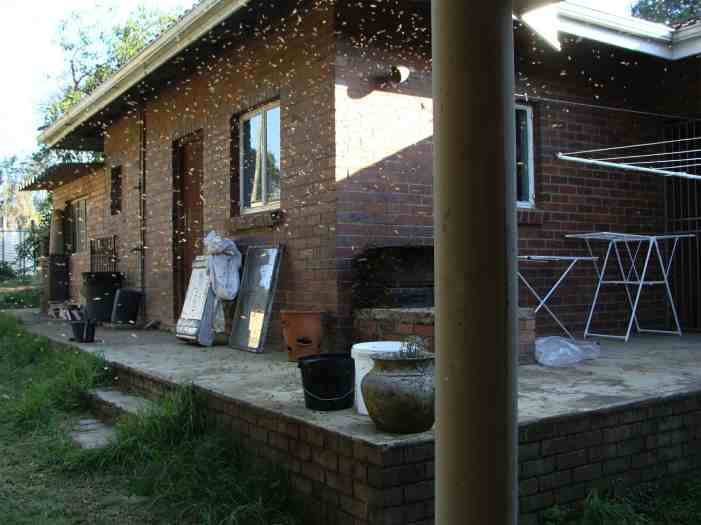
This page was last updated by Bernard Preston on 3rd June, 2021.
But secondly, it is an opportunity to spread the species, not unlike Columbus sailing out into the unknown. And that is done via swarming bees; a new queen is bred and, just before she hatches, the old lady and half the colony move out on a warm sunny day in search of a new home.
Several days before the bees swarm, scouts go out into the neighbourhood looking for a suitable hive site. When you see them moseying about an outside shed, under the eaves or in a pile of boxes, then there is a possibility that a new colony will be arriving on the next hot, sunny day.
You notice a build up of workers sussing out the chosen site, cleaning out any debris and getting Buckingham Palace ready for Her Majesty. Suddenly, there is a loud droning sound and the sky is filled with tiny flying black dots. Slowly the bees congregate on the box, and landing all around, in this case on the brick wall.
Queen Bee is somewhere there, but you are unlikely to see her; she's a little larger than the rest, but very shy and they keep her well out of view.
Within a few days the organised beekeeper will make sure that he puts frames with wax into their new home. They often build diagonally across the hive otherwise.
Back in the old hive, usually half a dozen queens are near to hatching. They start to make a loud trumpeting sound from within the still-sealed cells.
That is the message for the old lady; get out, or you'll be attacked and most likely killed by the first young virgin queen to hatch, unencumbered by literally millions of fertile eggs in her abdomen.
In the honey flow, a queen can lay up to 2000 eggs per day. She is no match for the young virgin. So she leaves, taking half the swarm.
Swarming bees
Swarming bees are one of nature's miracles; a wonder to behold.
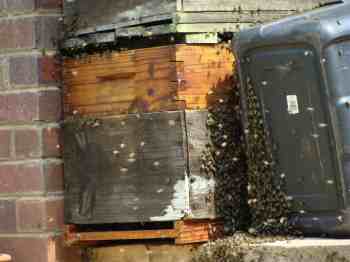
Around any beekeeper's home there are invariably half a dozen empty hives. They smell of honeycomb and propolis; the perfect place for a new home.
Watch closely and you'll see the bees scuttling in.
These bees arrive mostly during a honey-flow, or if their old home has been destroyed for one reason or another. At this time, an organised beekeeper will make sure old boxes like these are full of the frames that hold the wax.
This wasn't honey-flow season, and this beekeeper was not prepared. Those boxes are quite empty without any frames. Now I have work to do to hive them properly.
Worst is if you do nothing for a few weeks; they are certain to build diagonally across the frames making a nightmare.
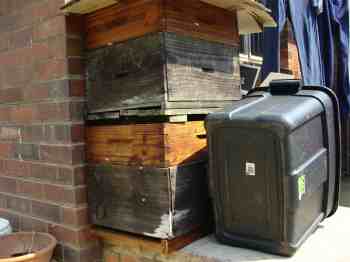
Ten minutes later there's hardly a bee in sight. The whole swarm has vanished inside. Immediately they will set about building new comb and within a day the queen will lay the first eggs; within three weeks they will start hatching and the future of the colony is assured.
If she is a strong, young queen, the growth will be exponential and within a few months there'll be the first bottle of surplus honey for the beekeeper. It could be you.
One of the mysteries is that they gather far more nectar than they need for their own consumption. In fact so much so, that the hive may become "honey-bound." They stuff it in every single cell so there is no room for the queen to lay her eggs.
There is only one way to alleviate the problem; the bees vacate the hive and swarm.
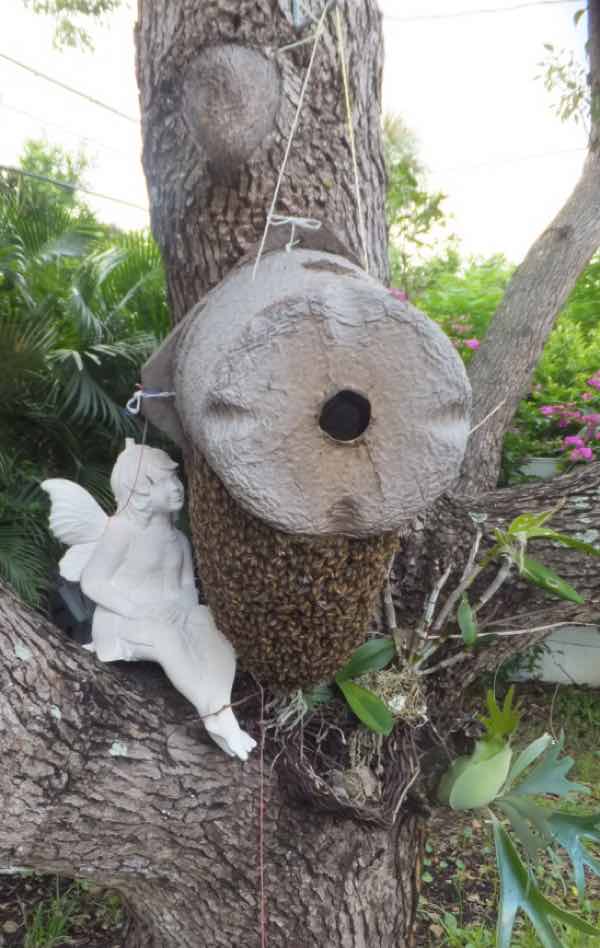
Trap nests and swarming
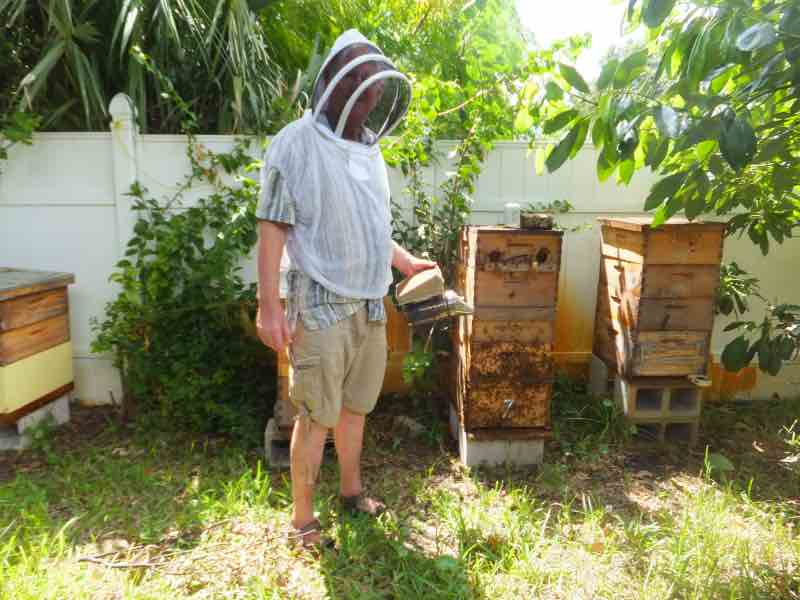
Bees have evolved to produce a new queen when the existing lady gets old, or when the hive is overflowing with bees, and they run out of room. In the wild, most nests are of a fixed size, so needing extra space often happens during nectar-flows.
Catching one of these often gets beekeeper a virile young queen, able to lay 2000 eggs a day, so the colony produces lots of honey.
The worker cycle is 21 days from egg-laying to hatching, so she needs room for nearly 50,000 larvae in all stages. Add in a day or so for cleaning before laying, and that means she requires almost 10 frames of just broodcomb at her peak.
The watchful keeper tries to prevent swarming by adding space as needed, and harvesting any honey so they are not driven to leave but to go and get more nectar. As you can see, one hive in the picture has 4 supers, and a lot of bees outside.
Clipping the wings of the queen to stop swarming is an exercise in futility; you are condemning the swarm to become weak with an aging monarch unable to lay enough eggs.
This is a strong swarm from which keeper Derek Lewis harvested most of the honey, and the next flow from Brazilian Pepper in Florida has just begun. This hive alone has produced over 50 lbs this year, and he is hoping for at least that much again very soon.
One of the beauties of keeping in USA, is that the bees are mild-mannered so heavy, full gear is not essential. His shorts have ties at the knees so they don't crawl up and mostly he only gets stung if he touches a bee accidentally.
Exploitation
The word exploitation has both a positive and a negative connotation.
- The use of something in order to get an advantage from it.
- The act of using someone unfairly for your own advantage.
Here are four contentious examples.
- We exploit the gentle nature and intelligence of Labradors as the perfect animals to be used for guiding the blind. In exchange the handicapped person cares for the dog.
- The ruthless exploitation of whales for their blubber almost led to their complete extinction.
- The Amazon forests are being exploited to plant soya beans to keep up with the demand of the world for vegetable protein.
- Honeybees are being exploited to pollinate the almonds in California to provide nut-protein for vegans.
I leave it to you to decide just where the keeper and his or her bees fit into this complex situation.
Three reasons why bees swarm
1. The old queen is worn out and simply is not able to produce her quota of eggs. They may just kill her when the young virgins are about to hatch.
2. The hive is too small; often they will produce multiple swarms of bees, each with a relatively young queen.
3. The hive is not suitable. Perhaps winter has arrived and a fire is being lit in the chimney; or it is wet in the rainy season, and so on.
At the end of the season the bees may go into hibernation in a very cold climate; the keeper makes sure they have enough stores to bide them over the winter. In spring they will be ready to take off again. Feeding kept bees may be misinterpreted by the uninformed; the intention is not that they should store the sugar solution; it can never be a substitute for natural honey.
For us oddly the low season is midsummer but there are enough flowers to keep them ticking over. Then just before the start of the new honeyflow we feed the bees to stimulate the queen to start laying a few weeks earlier than she normally would in anticipation of the fat year to come.
Fat and lean years, they are part of life.
Other bees
Nature is wonderful in providing us with many other bees than the more familiar ones I am breeding. We need them all.
All these bees are affected by the indiscriminate spraying of insecticides, loss of their natural habitat and the planting of monocultures.
Bee stings
When a bee stings you, the organ is ripped out of its abdomen, and it dies. Occasionally one might get a warning prick and both you and the insect are lucky enough that the barb doesn't become embedded in your flesh.
A bee stinger can inject a large volume of the toxin, up to 50 micrograms, so it's best to immediately use a knife-blade to scrape it off the skin; or a long fingernail. Pulsating muscles can be seen pumping more of the venom into the wound.
But do not grasp the stinger between the fingers as you'll squeeze more of the venom into your body.
The main component is a protein called melittin[1]. It destroys cell-membranes and blood corpuscles; and activates pain receptors, releasing histamine. Inflammation and swelling soon follow.
Other components are various enzymes like hyaluronidase; they drop the blood pressure, inhibit coagulation and also attack cell-membranes.
There are according to Professor Jamie Ellis from University of Florida over 50 different compounds in the venom, many not well understood.
Other bees are attracted by the scent of the venom, meaning you are likely to get stung many more times if you hang around. Ducking through bushes is the best way to escape the avenging cloud.
It is quite normal for the site of the bee sting to swell and be very painful; however if a reaction begins at a distant place, say hives on the skin around the abdomen, or at the throat then it's best to get to the emergency rooms immediately. An allergic reaction called anaphylactic shock can kill within a very short time.
Roughly 1% of people are allergic to bee stings, but everyone experiences pain and local swelling.
Second only to a vicious creature called a human-being, bees kill more people than any other animal. Horses are third in line.
Schmidt in his book, The hive and honey bee, lists the following reactions to stings.
- Normal, non-allergic reaction.
- Normal reaction lasting days.
- Large local reaction at the site of the sting
- Allergic reaction of the skin away from the site; not life-threatening but worrying.
- Non life-threatening systemic allergic reaction.
- Life-threatening systemic allergic reaction sometimes called anaphylaxis.
- Pain, redness, swelling and tenderness at the site.
- Itching, residual redness and swelling at the site.
- Massive swelling at the site lasting up to a week.
- Hives, swelling, itching and redness remote from the sting site.
- Allergic reaction in nose and eyes, minor breathing problems, nausea and vomiting.
- Shock, fainting and unconsciousness; breathing difficulty, massive swelling in throat, tongue and mouth. High pulse rate, dizziness; and possible death.
At stage 5 one should immediately get the victim to the emergency rooms; you have no idea whether it will progress to 6 or not.
It is estimate that 1 or 2 people in a 100 will experience an allergic reaction, stages 4 to 6, after a bee sting. It is caused by massive tissue destruction releasing large amounts of histamine into the vessels; this results in extreme dilation and drop in blood pressure.
Laying the patient on their back and raising the legs would help.
Ellis reports that African bees are no more venomous but they are more sensitive and attack in greater numbers.
Newsletter
Our newsletter is entitled "create a cyan zone" at your home, preserving both yourself and Mother Earth for future generations; and your family too, of course. We promise not to spam you with daily emails promoting various products. You may get an occasional nudge to buy one of my books.
Here are the back issues.
- Investing in long-term health
- Diseases from plastic exposure
- Intensive lifestyle management for obesity has limited value
- A world largely devoid of Parkinson's Disease
- The impact of friendly bacteria in the tum on the prevention of cancer
- There's a hole in the bucket
- Everyone is talking about weight loss drugs
- Pull the sweet tooth
- If you suffer from heartburn plant a susu
- Refined maize meal and stunting
- Should agriculture and industry get priority for water and electricity?
- Nature is calling
- Mill your own flour
- Bake your own sourdough bread
- Microplastics from our water
- Alternative types of water storage
- Wear your clothes out
- Comfort foods
- Create a bee-friendly environment
- Go to bed slightly hungry
- Keep bees
- Blue zone folk are religious
- Reduce plastic waste
- Family is important
- What can go in compost?
- Grow broad beans for longevity
- Harvest and store sunshine
- Blue zone exercise
- Harvest and store your rainwater
- Create a cyan zone at your home
"These days I don’t get stung too much; maybe 50 a year. It is very patchy; depends on a lot of things.
I react locally quite vigorously when I have not been stung for some months and then hardly at all after that; until a longer period passes since I was last attacked by a bee.
This is the most significant danger for people who get stung a lot. They can have a vigorous swelling after a break; and even a dangerous reaction.
I have not had any systemic responses since the very early days when I was still developing tolerance. Those distant reactions were only some itchiness and reddening both of which are typical and appropriate; and never any breathing difficulties."
- Mike Allsopp, bee scientist
Raw honey
Raw honey is a rare product these days; most is heated and highly filtered to remove any "foreign particles." That unfortunately includes the pollen that makes it so unique.
You either keep hives yourself, and it all starts with swarming bees or you find a small keeper who can assure you that he has not meddled with this nutritious choice food. You won't find it generally in supermarkets.
The irony of it is that raw honey requires less processing and really should be cheaper; it's easier to produce. But because it is so rare, you will pay a premium.
Find your own bees. It has been the hobby of a lifetime, the one that has stuck for over sixty years. Remembering too that keeping a few hives is one of those that definitely pays its way; last year I harvested over five hundred 500g jars from ten colonies; this year it's going on 700.
We always have a few extra Rands for little luxuries. This year it is going to be a top-notch Canon camera that I've been wanting for a long time; all paid for thanks to swarming bees.
Or find a local beekeeper. Most of the honey on supermarket shelves is imported with a very great likelihood of being adulterated with high fructose corn syrup; you will be none the wiser.
It's a good general rule in any case to eat locally-produced food wherever possible; it will be fresher, probably far better and lessen your carbon footprint.
choice foods
Raw honey, rich in pollen is one of nature's choice foods; better still we should eat natural comb, but that is impossibly expensive for all but keepers and the idle rich. But the bottled stuff you buy in the supermarket, in the main can best be described alas as highly-processed junk; rather consider a hive or three in the garden for some of those swarming bees.
If you're serious about your honey, think about your own bees for you and your children; it has been the hobby of a lifetime.
Last week a new colony moved into one of my swarming bee traps, so the last few days have been busy with preparing a spot for them. Two trees, unwanted in any case because they shade the veggie garden have to come down.
Having these swarming bees in the garden results in 100% pollination too; that means masses of butternut squash, fresh green peas and the like.
It's a sobering thought that bees are the only creatures that humans are utterly dependent on for their existence; they pollinate one in three mouthfuls of our food.
Bernard Preston
Bernard Preston is a retired DC, catcher of swarming bees, organic gardener, solar guru and general wellness nut; oh, and a writer too. His paperbacks are dirt cheap on Amazon as Ebooks.
Now with thirteen hives, he has enough. Then he will have ample honey for Christmas and birthday gifts and making mead. They never make white elephants!
Bee under the mitre
Of course, there are several stories about beekeeping in all three of my books of anecdotes. Read one of the free tidbits from Bats in my Belfry.
Bee under the mitre is one of my favourite stories.
Special honey is another short story; a gem by Geoff Elliott.
Only $2.99 buys you the Kindle version to read on your favourite eReader. Download Bats in an instant from Amazon.
vegans
My brother and I were introduced to beekeeping by our grandfather who was a strict vegetarian.
Today he would have been called a vegan; he wouldn't wear a leather belt shoes for example. Even though we are talking about a period nearly one hundred years ago, he already instinctively new that sugar was bad news. All sweetening was done with natural honey.
Did you find this page interesting? How about forwarding it to a friend, or book and food junkie? Better still, a social mead tick would help.
- Bernard Preston homepage
- Beekeeping
- Swarming Bees
Address:
56 Groenekloof Rd,
Hilton, KZN
South Africa
Website:
https://www.bernard-preston.com